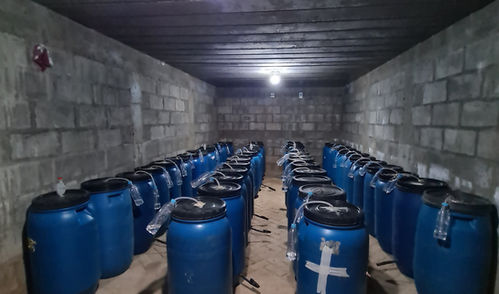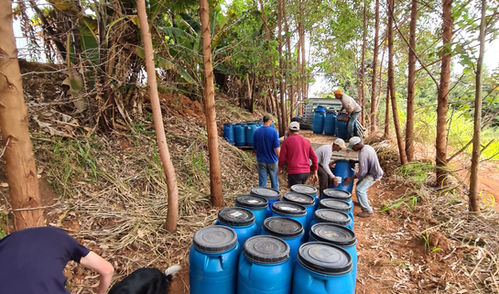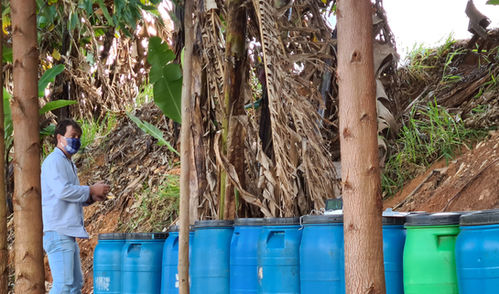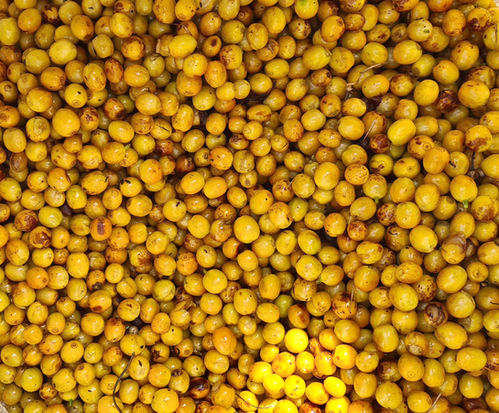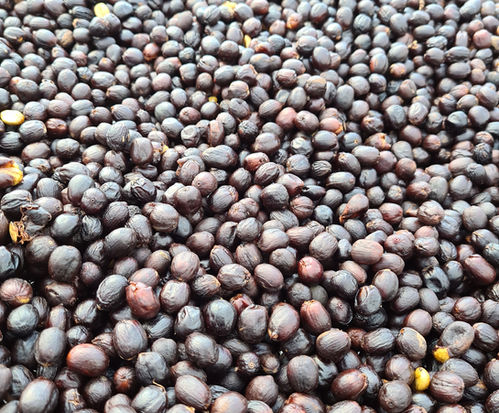
The farm
Our structure detailed for you!
Structure
Planned in its entirety by its founder, Jung Han Kim São Sebastião Farm has a postharvest structure that preserves to the final consumer’s cup all of the coffee’s characteristics.
After acquiring the farm, he organized the cultivation of different coffee varieties and, at the same time, built the processing structure so that the harvest could support the volume of coffee produced with enough space for adequate handling. He positioned the machinery so that the force of gravity would conserve power and resources, making the setup more sustainable
With a vast array of equipment and processing areas, São Sebastião farm produces a considerable range of micro-lots. With rigid control of tracking and monitoring of the coffee, it is ensured that every year the data regarding the best processes that satisfy different consumers is collected.
The postharvest structure is composed by:


Mechanical Siphon
The mechanical siphon has the purpose of washing the fruits that come from the field, making the first separation, and selecting the best beans. Whilst washing, it’s possible to remove the ripe fruits from the too ripe and the not ripe enough. From the siphon, the coffee known as peeled cherry originates, which is nothing more than the peeled fruit. When it doesn’t go through the peeler, the coffee goes to a drying patio and it becomes the natural coffee.
The cave
This is a project unique to Fazenda São Sebastião. In 2018, we decided to build a place with stable temperature, lighting and humidity. That enabled the repetition and improvement of fermentation that showed positive results. We planned the construction of the cave near the coffee unloading area to facilitate handling and used materials to control the temperature and conditions required for the fermentation. The construction was covered with dirt and grass to further improve the temperature control.
Bananeiras – “Banana trees”
Looking to better the fermentation conditions of the coffee batches, in 2020 he made room near the processing area where banana trees grow to ferment the coffee in a cool and shaded place. This allowed for a greater volume of coffee to be fermented in more adequate conditions.
Waterfall
Another fermenting spot for micro-lots of coffee is in one waterfall located in the farm property. In it, it’s set tanks for fermentation for upwards of 15 days.

Fermentation Silos
In 2019, Mr Jung conducted the construction of silos near the siphons for fermentation on larger scales. In these silos is fermentate natural or peeled cherry coffees either dry or with water.
Concrete Patio with 5000 square meters
In the concrete patio, the coffee dries efficiently and avoids contact between the beans and the soil. In it, it’s laid out in big lots as well as in micro-lots for drying. Thanks to its extent, it’s possible to manage different drying processes in it at the same time.
São Thomé Stone Drying Patio
In this patio, it’s typically set to dry unripe beans and select micro-lots because the drying process in the stone brings unique sensorial notes.
Raised Drying Beds
Along the concrete patio were built raised drying beds, also called African drying beds. In them, it’s set an ample assortment of micro-lots, especially Honey (the peeled beans that maintain the mucilage) for a more uniform and slower drying process.
Raised Drying Beds inside a Greenhouse
In these, it's set processed coffees from lots that stay drying up to 45 days. Since it’s located inside a greenhouse, the drying beds are shaded and provide a slow drying process, enhancing the sensorial notes that would fade in faster-drying methods.
Greenhouse
In the greenhouse, the beans are placed on the concrete floor for drying. In a controlled environment, safe from winds and rain, it is possible to produce high-quality coffees with high ratings.
Rotary Dryers
The rotary dryers are often used in coffee farms all over Brazil. With the size of São Sebastião’s farmed land, they are essential for drying the beans with greater effectiveness so that larger volumes of coffee can be processed at the same time with the same quality. Often, these dryers are used to finish the drying process of some micro-lots because there are two separate chambers, meaning they bear less volume.
Static Dryers
The static dryers were acquired in 2018. After visiting some farms and sharing knowledge with other producers, Mr Jung, who is always looking to keep himself informed, decided to acquire four containers to further the options for the drying process during the harvest. Unlike the rotary dryers, the static dryers carry less coffee to dry the beans by dehydrating them.
Resting Silos
After drying the coffee will stay in the resting silos for a while, where hot air can be pumped in to continue the drying and, reaching the desired humidity levels they can be transferred to the storage silos.
Storage Silos
The storage silos are used to store the coffee beans before resting. In them, the beans are preserved with the peel or parchment, that way, when the time comes they can quickly be peeled and commercialised.
Reprocessing
Post-Harvest processing
Every year, São Sebastião Farm does intensive work monitoring and analysing the data from its post-harvest. Because it is a certified farm, it has rigid monitoring of rastreability for every coffee that comes from the field. With their wide and varied post-harvesting structure, there are infinite possible processes to value and enhance the potential of the beans.
Because of this, during the harvest decisions can be easily made by the farm's personnel. This is crucial when making work with quality and care. Every member that works on the post-harvest comprehends what they are working on every day. Due to the engaged members and the farm's good structure, it is possible to produce individual lots in accordance with the client’s demand.
Projects
Under the goal of operating with excellence in the production of speciality coffee, São Sebastião farm organizes projects to develop its team, equipment and processes.
Team qualification
Frequently, qualification courses are administered to the farm's staff. Besides courses aimed at crop management, it’s given post-harvest, coffee grading, tasting, roasting and extraction courses.
The staff training programs happen frequently because the farm's management believes that every person who is part of a project, needs to develop and understand more broadly what they do every day. Having this awareness, they can perceive the importance that their task has in the broader context of speciality coffee production. In other words, in addition to producing excellent coffees, the farm has genuine concern and care to develop their team.
.jpg)
Authorship process
With the farm's qualified team and processing structure, São Sebastião farm can carry out any post-harvest process they research and believe is the best to extract the most from the coffee.
In this exchange of information and execution of the processing in the post-harvest, everyone goes through a unique learning experience that, in itself, has an immeasurable value for the farm's team.

Nature preservation
São Sebastião farm has 34 springs and those that are not protected by the forests are fenced and reforested yearly. Everyone involved with the work of the farm believes in the need to preserve nature, both fauna and flora. Respecting the area that has been under our responsibility since 2012, we produce excellent coffee, provide better living conditions for people and preserve nature. On the farm, the word sustainability has a meaning that goes beyond paper, as it guides our daily actions.

Roasting Process
The farm also has a small scale roaster. In it, all of our coffees are roasted for tasting and evaluating to determine any necessary adjustments in its production. Coffees that are consumed internally and some coffees for a few buyers are also roasted there.

Biological management
With the conversion of one of the farm's fields to organic farming, the farm’s team came into closer contact with the biological management of the coffee plant. With this, from 2020 forward it was possible to conduct this management more frequently on the farm, with the acquisition of a bioreactor for the production of inputs by our team.
In addition to implementing this management for the organic coffee fields, we began to use it whenever possible in the conventional coffee fields. We believe that with all the care and follow-up we can increase the use of these agricultural inputs over the years.

Pest and diseases monitoring
Within this philosophy of respect for nature and for the human beings who live off the work of the land, the farm structured an intense monitoring work of pests and diseases of the coffee plantation so that each year it can reduce the use of pesticides. To reinforce this work, it started using traps against coffee pests.

Weed management
Another important item that differentiates the farm from conventional farming is the concern with weed management in the most natural way possible, without the use of pesticides. To that end, the farm has acquired ecological brush cutters and planted vegetal species to reconstitute the soil’s life within the coffee plantations.


